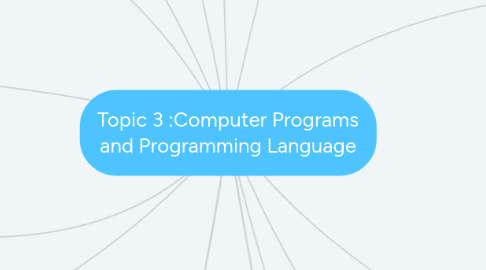
1. Common Programming Paradigms
1.1. Imperative paradigm
1.2. Object-oriented paradigm
1.3. The functional paradigm
1.4. The logic paradigm
2. Imperative Paradigm
2.1. Describe how the computer should achieve solution
2.2. Example of languages : C, Pascal, FORTRAN, ALGO 60 & COBOL
2.3. Object Oriented Paradigm
3. Object Oriented Paradigm
3.1. Based on imperative / procedural style with added data & code abstraction & encapsulation
3.2. A revolutionary concept that changed the rules in computer program development OOP is organized
4. Logic Paradigm
4.1. A declarative and relational style of programming
5. Functional Paradigm
5.1. Based on the concept of functions in mathematics
5.2. Based on Lambda calculus
6. Scientific Application
6.1. John Backus’s team at IBM developed FORTRAN (for FORmula TRANslator) in 1955-1957.
7. Artificial Intelligence
7.1. Artificial Intelligence deals with emulating human-style reasoning on a computer.
8. Artificial Intelligence Languages
8.1. The first AI language was IPL (International Processing Language, developed by the Rand Corporation. Its low-level design led to its limited use.
9. Systems Programming
9.1. Assembly languages were used for a very long time operating systems programming because of its power and efficiency.
10. Web Software
10.1. Eclectic collection of languages:
10.1.1. General-purpose (e.g., Java) – can be used for a wide range of programming jobs.
11. Overview of computer program and programming language
11.1. Computer Program
11.2. A computer program is a set of instructions that the computer needs to follow to process the data into information.
11.3. They tell the computer:
11.3.1. What actions you want the computer to perform
11.3.2. The order those actions should happen in
12. Programming Language
12.1. A programming language is a system of signs used to communicate a task/algorithm to a computer, causing the task to be performed.
12.2. The task to be performed is call computation, which follows absolutely precise and unambiguous rules.
12.3. Computation
12.3.1. Computation is any process that can be carried out by a computer.
12.4. Machine Readability
12.4.1. For a language to be machine-readable, it must have a simple enough structure to allow for efficient translation.
12.5. Human Readability
12.5.1. It requires that a programming language provide abstractions of the actions of computers that are easy to understand, even by persons not completely familiar with the underlying details of the machine.
12.6. 3 levels of Programming Languages:
12.6.1. Machine Language
12.6.1.1. The representation of a computer program which is actually read and understood by the computer.
12.6.2. Low Level Language (Assembly Language )
12.6.3. High level Language
12.6.3.1. A programming language which use statements consisting of English-like keywords such as "FOR", "PRINT" or “IF“, ... etc.
